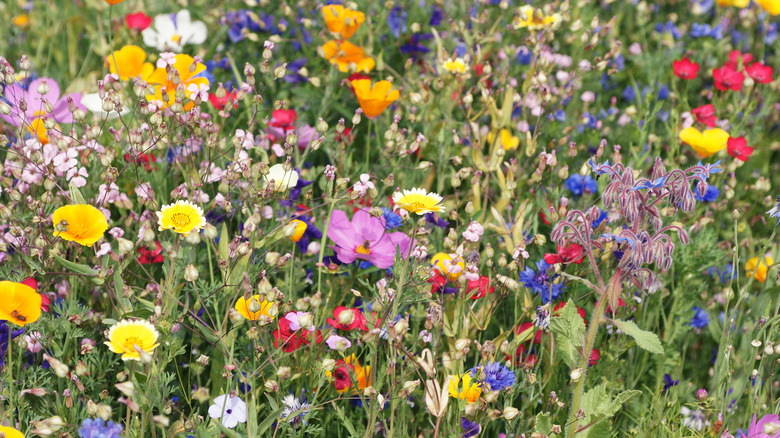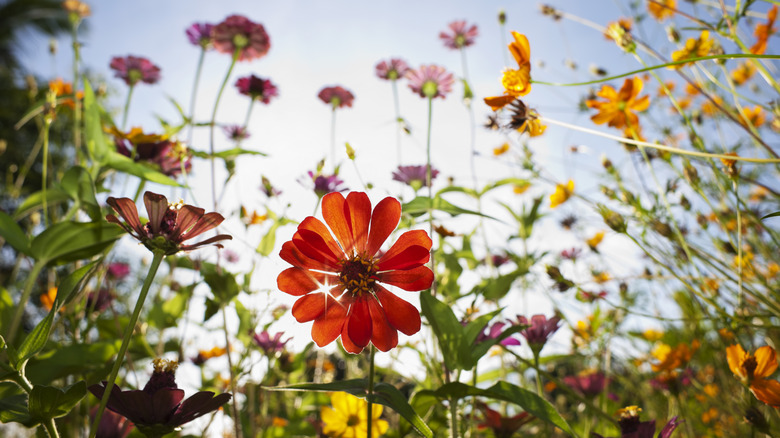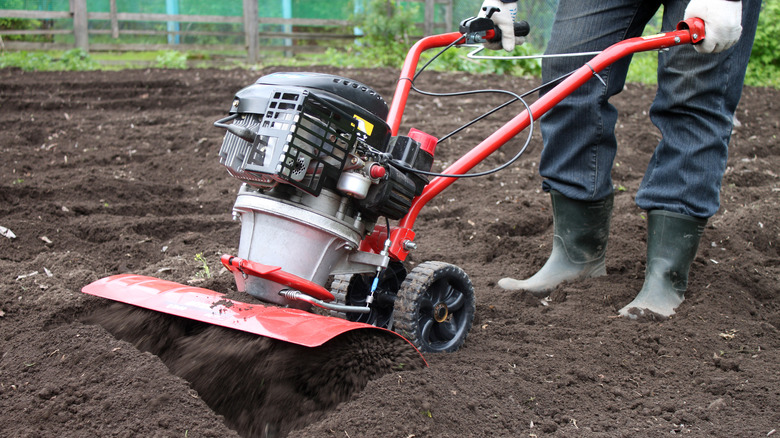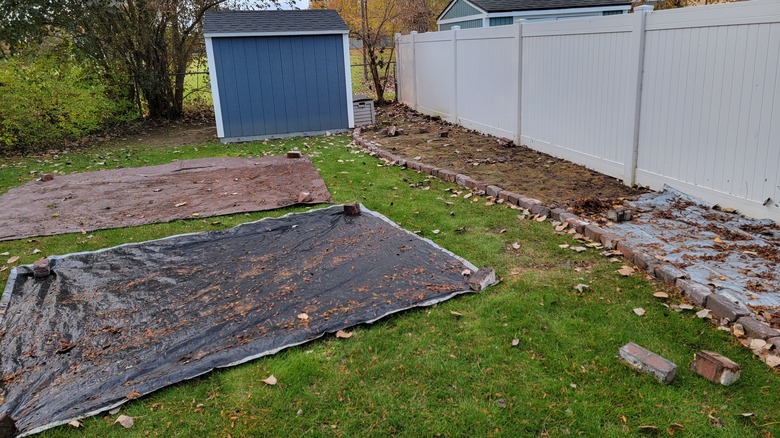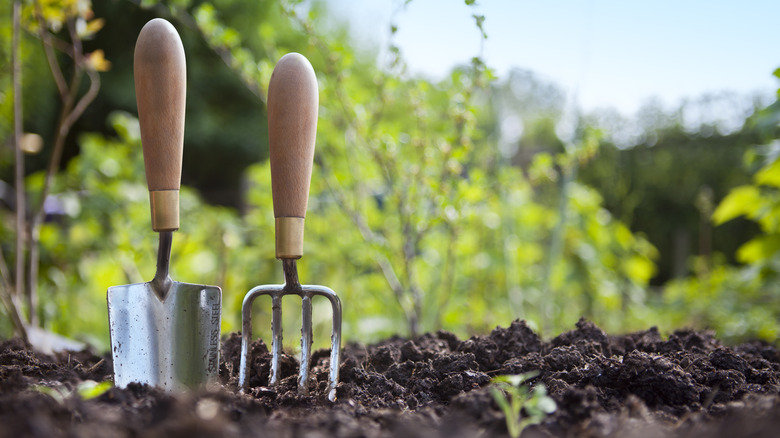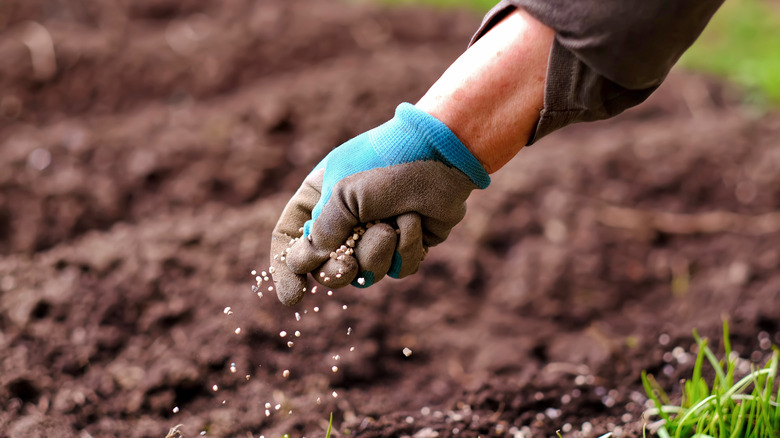Our Professional Gardener's Tips To Turn A Patch Of Lawn Into A Field Of Wildflowers
With increasing awareness about the environmental importance of pollinators and the worrying trend of colony collapse disorder in recent years, many gardeners are interested in planting more wildflowers. There are a few different ways to transform a patch of lawn into a field of wildflowers, each catering to different budgets and preferences on small and large scales.
A few factors will help you decide which approach you should use. Wildflowers do need a sunny location and a bit of space, but this project can also be done on a small scale. Even a small 4 by 4-foot square can help your garden attract pollinators. Once you've created your patch, a wildflower field is very low maintenance, requiring only mowing in the late autumn, if desired. But the initial work can be time-consuming — and possibly costly, depending on what method you choose.
Will the reseeding habits of wildflowers affect your other garden beds? The answer is very likely. The sustainability of wildflower fields depends on the reseeding of flowers each year. One way to prevent this from becoming too problematic is to place your wildflower field at a good distance from your other flower beds. You can also reduce the spread of invasive plants by carefully selecting your seed mix (which I really enjoy doing) and eliminating any varieties you don't want to deal with. In my experience as a professional gardener, black-eyed Susans or Heliopsis helianthoides can be very invasive are are best avoided.
Creating a wildflower field on a budget
This is a project that can definitely be done on a budget. One nice thing about having wildflowers is that they're a gift that keeps on giving! For one, they tend to reseed themselves, so there's no need to keep adding new plants every year. The decaying plant matter also adds nutrients to the soil at the end of every season, so adding amendments shouldn't be necessary after you put the first layer of soil down. Some plants even put out seeds in autumn that can be collected and planted in bare spots.
To prepare for your wildflower garden, check out seasonal sales online for wildflower seed mixes or individual packets of seeds. Some seed mixes are created specifically for certain climates or geographical locations. Check with your local community garden organizations to see if they have a seed library or free seed giveaways. Seed packets that are past their expiration date are usually still viable for a year or two.
Soil can be expensive. For a larger area, investing in a bulk topsoil delivery may be the most cost-efficient method. If your wildflower patch is going to be somewhat small, you can buy bags of soil. When I go to garden stores and nurseries I always get the marked-down bags of soil and amendments that have been torn and taped back together, often for half price. Also consider the free amendments you can add to amend and improve basic topsoil: crushed eggshells, home-made compost, wood ash (from untreated wood), and used coffee grounds.
Use a tiller to break ground
If you're trying to make a fairly large wildflower meadow — bigger than, say, 6 by 6 feet — you may want to use some larger equipment to break ground. The advantage of doing it this way is you can use some of the existing soil in your yard. This also saves you physical labor by breaking up clods and loosening the soil. Tilling is best done in spring before plants have gone to seed. I have found that it's also easier to do after a rainfall, when the ground is moistened but not wet.
If you don't own a tiller, you can rent one from some garden or hardware stores, or local tool libraries. You could also purchase a garden tiller, but they're expensive, and this is only practical if you'll use it often. A cultivator is another option that costs much less, but may not be quite sturdy enough for the job, depending on the texture of your soil and the amount of grass.
You can also hire someone to do the tilling for you. This one-time expense might be worthwhile if it helps you get the project started. Once the tilling is done, use a rake or hoe to remove grass clumps, roots, and large rocks. When the soil is loosened, you can add soil amendments, mix them in, plant your wildflower seeds (more on this below), water them, and wait for flowers to appear.
Try tarping to kill weeds and grass first
It may seem counterintuitive to kill grass and weeds when your ultimate goal is cultivating a plot of ground. But planting wildflowers is actually much easier if you start with some fertile soil that will encourage the germination of seeds. This is much harder if the chosen spot is already thick with undesirable weeds and grass. Using a tarp is a safe way to get rid of weeds without chemicals, but it takes time and planning.
Smothering weeds with a tarp prevents sunlight, moisture, and air from reaching these plants. The common term for this weed-reducing practice is soil solarization. A standard tarp works well, or you can use heavy black plastic contractor trash bags. Lay the tarp or bags over the area and weigh it down with something heavy like bricks, cinderblocks, or wood. Then, the waiting begins!
It usually takes a few months for the tarp to kill the majority of the grass and weeds. if you lay the tarp in late summer or autumn, you may be able to use the space for planting by the following spring. Starting earlier and leaving the area covered longer (i.e., spring to spring) may bring more success. Even if there are still some plants growing, their root systems will be weakened, and you can clear them out with a rake, tiller, or cultivator. After clearing away the roots, I add in some garden soil and amendments before planting seeds.
Try this modified lasagna gardening technique
Lasagna gardening makes it easy to create a new planting area without tilling or even digging. Also called sheet composting, this is a method of no-till or no-dig gardening. Usually, it includes a raised bed frame of wood or metal, but for a wildflower field, you don't need as much depth of soil as you would for a vegetable garden. So you can essentially create a modified version of the lasagna gardening technique.
The only materials you need are cardboard and soil — laying down cardboard and putting soil on top smothers any grass or weeds beneath. From here, the cardboard slowly breaks down over time to integrate the new soil into the old layer. Before beginning, mow the area and remove any large weeds or plants as best you can. Grab some heavy-duty cardboard, such as shipping boxes (I save these up until I have enough), and remove any tape, labels, or staples. Now, lay down the cardboard and overlap the pieces so there are no gaps.
If you like, you can put down a layer of composted leaves or natural wood chips first. Mix in other soil amendments before adding soil to keep things more manageable. Then pour a few inches of soil over the surface of the cardboard. Most wildflowers will grow fine in a 4 to 6-inch deep layer of soil. Gently rake the soil surface to level it out. That's it! You're ready to plant.
Planting your wildflower field
Regardless of which method you use to create your planting area, planting wildflower seeds is the same process. You can do this in either spring or fall, but spring will let you get your patch of wildflowers established and growing during the warm season. This will bring more pollinators and wildlife as they become aware of its potential as a winter habitat.
It takes about ¼ pound of wildflower seed mix to plant a 10 by 10-foot area. If you have a small area, you can get some mixed seed packets, or buy individual seed packets and mix them together. A good mix for Zones 3-6 would include cosmos, larkspur, delphinium, bachelor buttons, partridge pea, African marigolds, prairie coneflower, love-in-a-mist (Nigella), California poppies, and zinnias.
Scatter your seed mix across the soil, but not too heavily. Aim for about 60 to 70 seeds for a 12 by 12-inch square. Don't worry if there are a few bare spots — they'll get filled in eventually. Gently walk on top of your seeds to anchor them. You can also toss another light layer of soil and compost over them — about ½ inch thick, if you want. For ideal timing, plant your seeds ahead of a light rain forecast. If there's no rain coming, I gently water the surface with my hose on a gentle spray setting or use a watering can. Water lightly every other day, or allow normal rainfall to work its magic.
Maintaining your wildflower meadow
Once your wildflower meadow is established, there is very little maintenance required. As birds and other wildlife visit the area, they may bring seeds from elsewhere. One thing to watch out for is undesirable weeds that crowd out other plants. This includes garlic mustard, large dock, bindweed (morning glories), or thistles. You can pull or dig these out individually, and it's best to do so before they go to seed in late summer to prevent them from spreading.
You can mow your wildflower meadow at the end of the season (or use shears to cut back the stalks by hand). I do this as flowers are going to seed, and then I let the stalks remain for a day or two on the ground. Then gently rake to remove the larger stalks, and some of the seeds will fall and reseed the area. Autumn is also a good time to plant some more wildflower seeds. Choose cold-hardy wildflower varieties and they will come up in spring.
You can also leave the meadow to decompose naturally in the fall and clean up any remaining dead stalks or leaves in the spring if desired, but you should wait until after the last frost to avoid disturbing pollinators. Don't "clean" too vigorously, as decaying plant matter provides valuable nutrients and shelter for pollinators and wildlife. As your wildflower meadow grows over time, you may decide that "less is more" in terms of maintenance.
